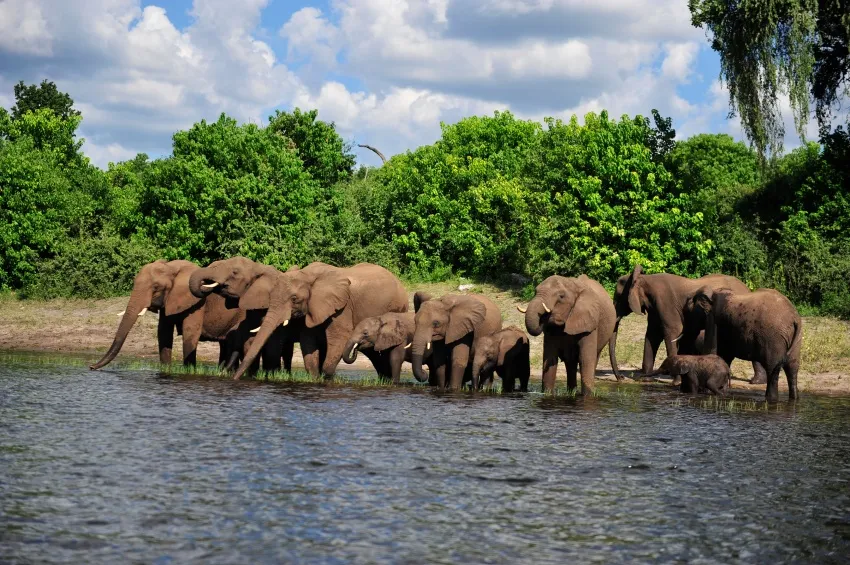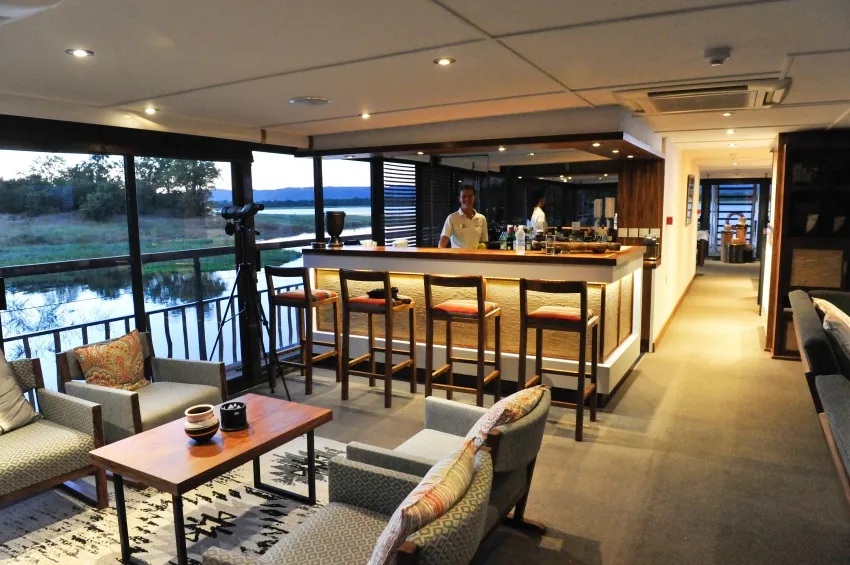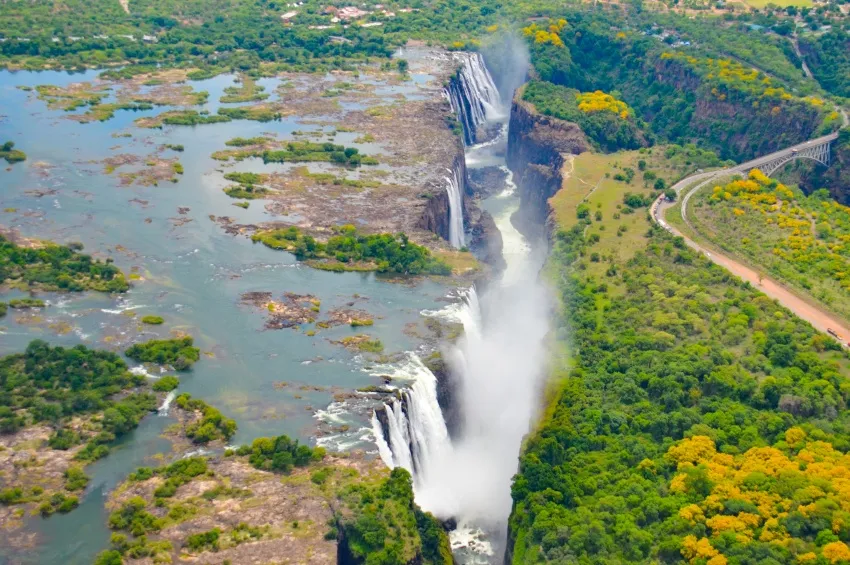- Home
Aboard the African Dream
Aboard the African dream
Luxury lodges, elegant river boats and the awesome majesty of Victoria Falls. Heidi Fuller-Love finds much to adore about a Lake Kariba safari cruise. But will she see the Big Five?

The crimson flush of sunset stains the water as our small powerboat pulls out from a clump of reeds and heads for the African Dream, CroisiEurope’s 16-passenger luxury vessel on Zimbabwe’s Lake Kariba. High overhead, a fishing eagle gives its lonely-owl cry, while a crocodile pokes sly eyes above the water to assess us. Then a baby hippo wanders into view and nibbles at a patch of grass in the shallow water. He continues browsing, content as any domestic cow, until we’re just a few yards away. Then he gives an angry little snort, tumbles heavily into the water and paddles off. If you love cruising and you also want to see Africa’s “Big Five”– lion, leopard, elephant, rhinoceros and Cape buffalo – CroisiEurope’s nine-day Safari cruise is a great way to have your cake and eat it. With three days sailing, there are numerous shore excursions, plus several days in a remote Namibian safari lodge, so the opportunities to spot wildlife up close are endless. “I think we would give your money back if you didn’t see anything”, jokes our press officer. The itinerary criss-crosses Africa’s “Four Corners”, the point where Botswana, Namibia, Zambia and Zimbabwe all meet, and we soon discover that it involves frequent (though usually interesting) stops at immigration offices to get the appropriate stamps in our passports. The flight from Victoria Falls in a six passenger prop plane is thrilling – our pilot swoops low over the snaking silver estuaries and small islets of Lake Kariba, as herds of startled impala scatter below. From the airport it’s a short drive along a muddy, bumpy track, where we meet zebra and baboons, before hopping aboard the powerboat that takes us to the African Dream.
A dream come true

Currently the only river ship to cruise both the Chobe and Zambezi rivers, Croisi’s new vessel was built in Zimbabwe’s Harare shipyard and it took her nearly a year to make the 621-mile journey to her Kasane homeport. Elegant as an old colonial mansion, the all-suite ship has stylish bedrooms with zebra-striped bedspreads and African-themed decor, and the goodsized bathrooms come with rain showers. Picture windows give magnificent views of the surrounding Lake Kariba – at 139 miles long, the world’s largest manmade body of water (created when the Zambezi River was dammed to provide Zimbabwe with electricity). A warm welcome from the ship’s crew is followed by the first in a succession of leisurely dinners, served in the ship’s glass-walled restaurant: tilapia fish from the lake, in a tangy lemon sauce,with a well-stocked cheeseboard and crème brûléefor dessert, served with an excellent bottle of South African wine. The following day we head out in small boats for our first water safari on the Gache Gache River. At its remote estuary in the eastern part of the lake, the Gache Gache is home to a huge diversity of wildlife. Our boat cuts through still waters where fishermen cast lines to catch enormous tiger fish, and on past petrified tree trunks where African darter birds stretch their wings to dry in the sun. Serenaded by a hundred wails, warbles and whistles, we slide into a small creek, hedged by butterfly-leaved mopane trees. Above us are lumpybeaked trumpeter hornbills, while vivid Malachite kingfishers flash back and forth above a pod of wallowing hippos. Our guide, Sam, tells us that these deceptively cute-looking beasts can be extremely aggressive. “Statistics show that hippos kill more people in Africa than any other animal”, he warns, as we head back to the African Dream for dinner.
Wild at heart

Up early the next day, we travel to Matusadona National Park. Bordering Lake Kariba, this famous 540 square mile reserve is home to many of the creatures that tourists cross continents to see, including waterbuck, cheetah and rare black rhino. Guide Patrick, waiting in a high-bodied safari Jeep, tells us that when the land was flooded to create the lake in the 1950s, hundreds of animals were left marooned on small islands. But then an enterprising employee of the Rhodesian parks and wildlife department, Rupert Fothergill, launched Operation Noah. “It was a rescue operation lasting five years, and more than 6,000 animals were saved and relocated – many of them right here at Matusadona”, Patrick tells us. All that morning we bump over dusty tracks, spotting marabou storks – “undertaker birds”, with their mourner’s cloak of feathers, and skinny white legs – as well as waterbuck and Nile crocodiles, whose sneering jaws reveal mouthfuls of gleaming teeth. Several times along the way, Patrick stops to point out lion prints, large as a child’s hand, that he says are fresh from the day before. He’s full of fascinating observations like this – also revealing that the mopane trees produce extra tannin when elephants are around, in order to make their leaves unpalatable Then, as Patrick talks, a large bull elephant breaks out of the undergrowth ahead of us. He is so close that I can see every tiny leathery wrinkle of hide surrounding his small irate eyes. He stands for a moment, staring at us, his trunk and magnificent curved tusks angrily raised. It’s a tense moment, and we are all relieved when he finally disappears into the woods with a last irritated shake of his immense, African-map-shaped ears. The following day, a small plane buzzes us back to Victoria Falls, where we take a bus and then a boat, crossing several borders en route, to reach Kasane. This remote village earned lasting fame as the venue where Richard Burton and Liz Taylor were secretly married – for a second time – in 1975. Our destination is Cascade Lodge on the island of Impalila – surrounded by the Zambezi and Chobe rivers, and only accessible by boat or light aircraft. We wait in a long line to be stamped out of Botswana, then climb back in the motorboat to be whisked – through blind alleys of papyrus, where yellow bellied weaver birds cling to their puffball nests – to Impalila Island’s main dock, where we’re stamped into Namibia. Gangplanks lead us across water channels fringed with reeds to the main lodge, where staff welcome us with song, and then take us to our vast suites. Truly a sight to behold, these have wooden decks with rocking chairs (ideal for those sunset cocktails), as well as plunge pools overlooking the fast-flowing Zambezi River. After croissants and strong coffee on the terrace next morning, we set out from Cascade on a full-day Jeep safari to explore Chobe National Park – home to more than a quarter of Africa’s elephant population. For hours we thunder up and down the winding dirt tracks, peering into the dense mopane forest, hoping to spot wildlife. By the time we break for tea and treats, we’ve seen herds of impala, as well as huge martial eagles and more crocodiles – but still no sign of the Big Five. Unable to hide our disappointment, we clamber back into the high seats of our Jeep, the heat now so intense that our hands are slippery with sweat. Then, amidst a thicket of trees, we see a long, spotted neck – and suddenly there are giraffes everywhere. Tall as houses, they balance stiffly on their improbably long legs as they munch leaves or gallop skittishly ahead of us across the savannah. Next there is a dazzle of black and white and we’re among a herd of zebra. These beautiful beasts kick their hind legs as they gallop toward a large warthog, whose moustache-like tusks and sardonic expression remind me of Salvador Dali. And then, finally, we happen upon a herd of African elephants with babies in tow. It is magical. “Africa is like that”, our guide says quietly. “There is nothing… and then there is everything.” We fly back to Victoria Falls the following day. After buzzing back and forth across “The Smoke that Thunders”, we are finally getting a close-up view of the natural phenomenon that was named by Scottish explorer David Livingstone in honour of his queen. Stalls hiring out oilskins at the entrance are a warning of the soaking ahead. For an hour we climb slippery steps and cross narrow bridges through dazzling rainbows of spray, admiring breathtaking views of this immense cascade, which is twice the height of Niagara Falls. By the end we are indeed drenched, but very happy to have enjoyed such a spectacular end to a truly fabulous cruise.
